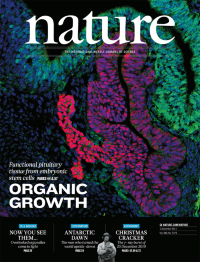Volume 480
-
No. 7378 22 December 2011
This week we identify Nature�s 10, ten newsmakers who have had a big influence on science in the past year. They are physicist Dario Autiero, seven-billionth baby Danica M. Comacho, US environment-agency head Lisa Jackson, radioisotope researcher Tatsuhiko Kodama, CERN engineer Mike Lamont, microbiologist and blogger Rosie Redfield, physics entrepreneur John Rogers, astronomer Sara Seager, former Egyptian prime minister Essam Sharaf and psychologist Diederik Stapel. Read about their contributions from page 437.
-
No. 7377 15 December 2011
How Japan deals with the radioactive and political fallout from the natural disasters of March 2011 that wrecked the Fukushima Daiichi atomic plant will have immense implications for the nuclear power industry worldwide. In a Comment piece this week, two prominent Japanese politicians, Tomoyuki Taira and Yukio Hatoyama, call for the nationalization of the plant as part of the recovery process. Only with the government in control, they say, can scientists find out what really happened and make the necessary plans to cope with the aftermath. One example of the inadequacy of the current arrangement is the redacted reactor-operator�s manual shown on the cover. Presented to a Diet committee by the plant�s operators, the document was rendered almost unintelligible by heavy redactions.
Nature Outlook
-
No. 7376 8 December 2011
The metre-long swimming invertebrate Anomalocaris was the top predator in the Cambrian ocean more than 500 million years ago. Recent discoveries of fly-like compound eyes attributable to this creature confirm suggestions that it is related to the arthropods — jointed-limbed creatures such as insects, crustaceans and trilobites — and show that compound eyes evolved before hardened exoskeletons. The superbly preserved fossils from South Australia show that Anomalocaris had exceptional vision. Its compound eyes are among the largest and most acute to have ever existed; each eye is up to 3 centimetres long and contains more than 16,000 lenses. The existence of highly visual hunters during the Cambrian would have accelerated the pace of the predatorprey 'arms race' then under way. Illustration: Katrina Kenny/University of Adelaide.
Nature Outlook
-
No. 7375 1 December 2011
A three-dimensional cell culture system has been developed that produces functioning pituitary tissue from mouse embryonic stem cells. The cells differentiate into layered structures, the development of which depends on close juxtaposition of two tissue types in formations that resemble local tissue reactions seen in vivo. Endocrine cells including corticotrophs and somatotrophs are produced. The corticotrophs efficiently secreted adrenocorticotropic hormone in response to corticotrophin releasing hormone, and transplantation of the pituitary tissues into a hypopituitary mouse model rescued a lethal deficiency in adrenocorticotropin. This work opens the possibility of developing regenerative therapies for pituitary defects, a major category of endocrinological disorders that includes empty sella syndrome, Sheehan syndrome and pituitary apoplexy. The cover image shows the developing mouse anterior pituitary expressing Pitx1 (red) at embryonic day 13, in contact with the neurohypophysis extending from the Rx+ hypothalamus (green).




